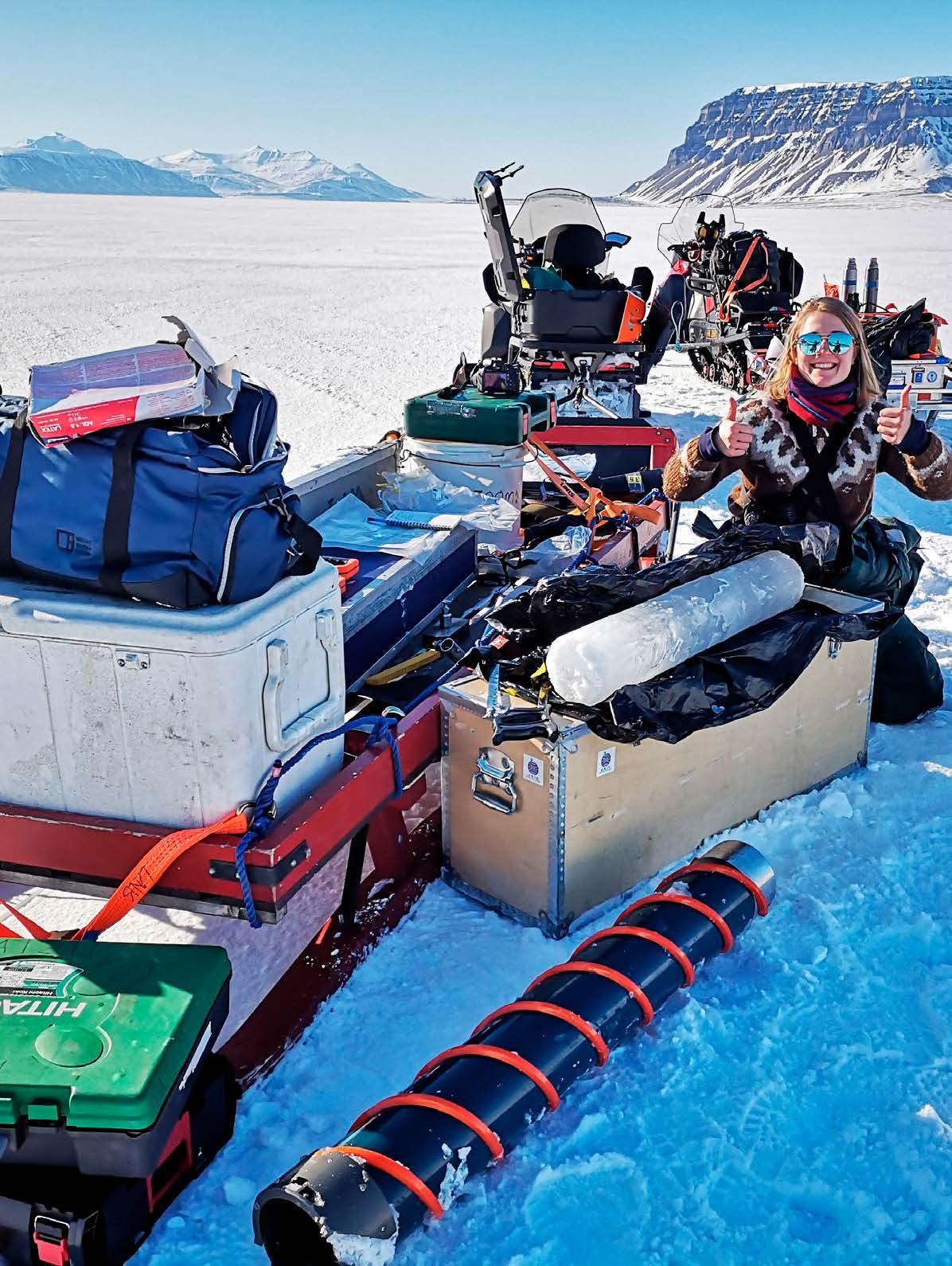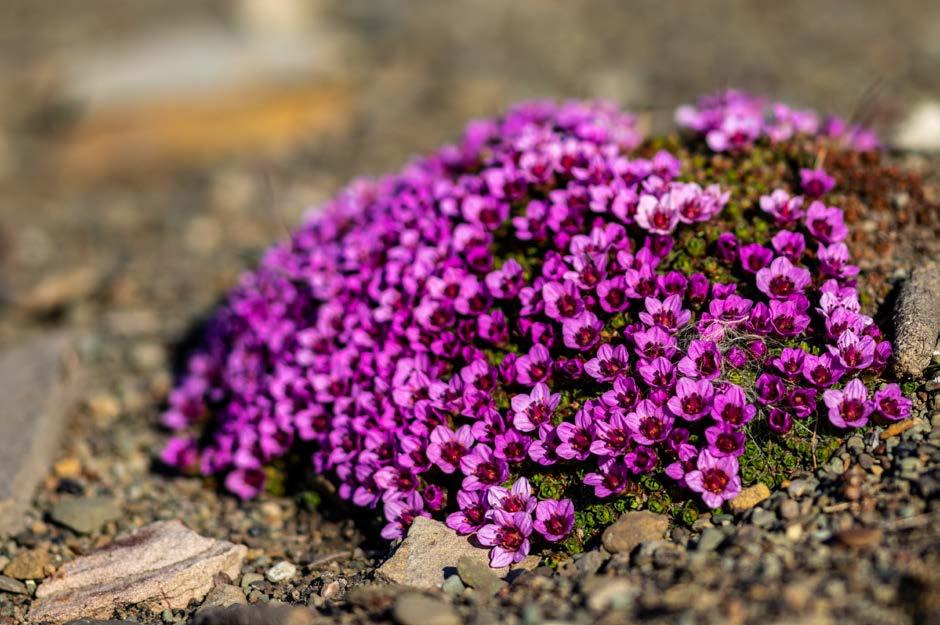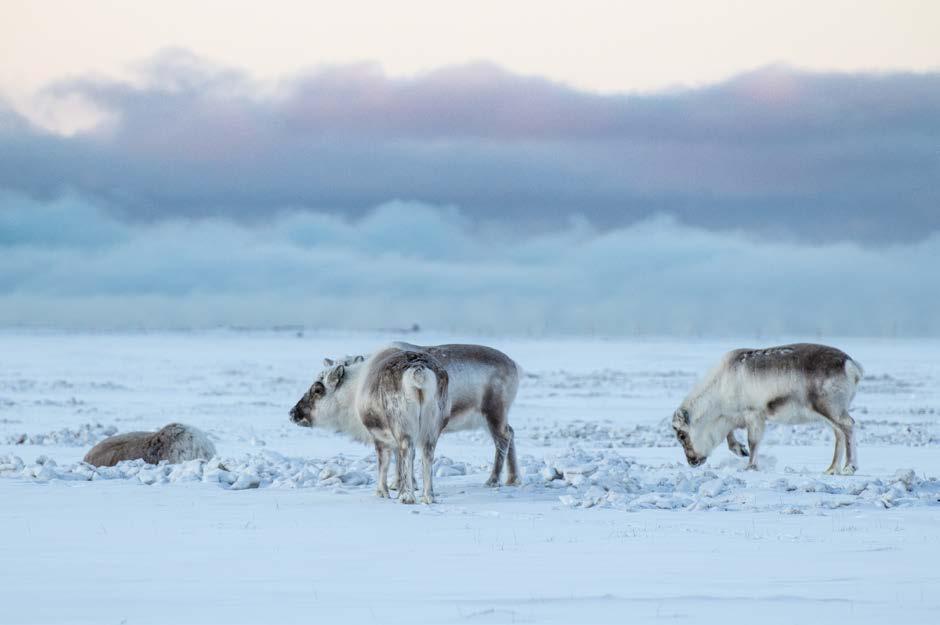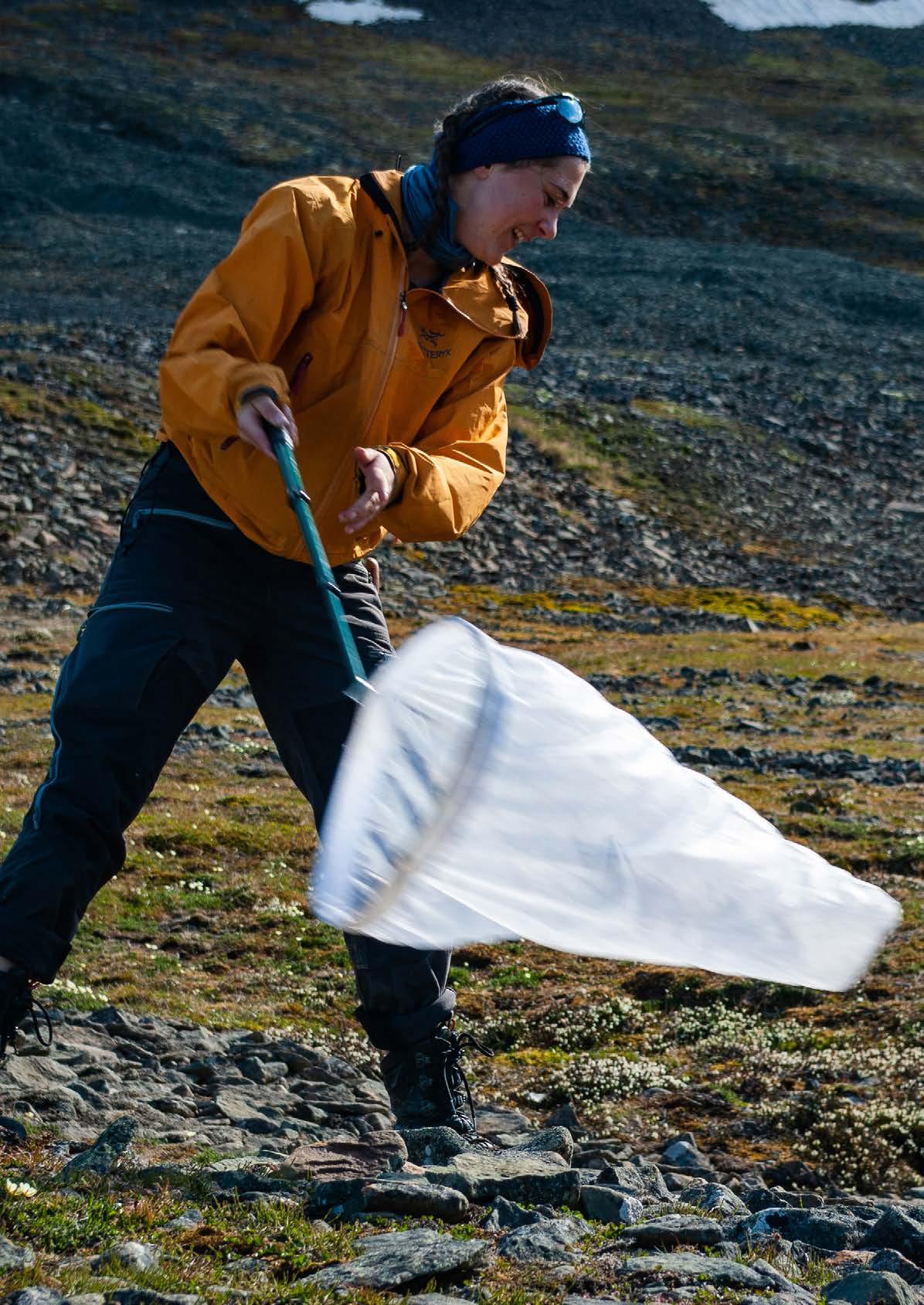
11 minute read
ARCTIC BIOLOGY
BY STEVE COULSON, HEAD OF DEPARTMENT
Arctic Biology (AB) provides a full one-year curriculum of undergraduate studies, as well as a range of master- and PhD level courses in biology. The department conducts research within biological climate effects, seasonality, and dynamics of species and ecosystems in space and time. Our strategy will strengthen our local, national, and international scientific role, founded upon curiosity driven, high scientific competence and yearround presence in Svalbard.
Advertisement
At the end of 2020, the AB department consisted of three professors, three associate professors, five PhD students, two postdocs, two staff engineers and eight adjunct professors. Two new PhDs and one post doc were hired during 2020.
EDUCATION
The course portfolio during 2020 was severely restricted due to Covid-19 and the cancellation of the autumn semester and many of the masters and PhD courses. Nonetheless, AB-202 and AB-203 were successfully completed although with adjustments for digital teaching and examinations.
Our aim is to be the primary study site for learning high Arctic biology through authentic experiences. Education at AB is research-based both in knowledge content and how we teach. Knowledge and skills are best mediated through student centred active learning and authentic research settings, and active involvement creates more motivated students and aid deeper learning. Based on this background AB has developed both a bachelor research project course (AB-207) and a bachelor internship course (AB-208). The courses give insight into research at AB and activities at external institutions that provide job opportunities after the students finish their education. This provides the students with more practical experience and generic skills that might improve learning outcomes in other courses and prepare them for later careers. The educational development in the AB department is to a large extent linked to the project bioCEED, the Centre for Excellence in Education (see separate chapter). Our focus on educational development has also led to more research on education within the department. The goal of the inter-departmental project FieldPass, is to develop and research alternative forms of assessment suitable for field-related learning. FieldPass employed

June 2020: Purple Mountain Saxifrage (Saxifraga oppositiofolia). Photo: Sil Schuuring/UNIS.
one postdoc and one technician in early 2020 but the first year of fieldwork was delayed due to the Covid-19 restrictions.
RESEARCH
The overall aim of the AB department is to remain a leading institution in high Arctic biological research with cutting edge methodology and infrastructure. Our goals embrace advancing fundamental knowledge on the ecology and evolution of Arctic species, formed by seasonal as well as long-term interactions with the biotic and abiotic components characteristic of the Arctic environment, including human impact. Our research covers three over-arching interlinked themes: Climate change biology, Seasonal ecology and Spatio-temporal dynamics of species and systems.
The department is partner in numerous projects, including largescale projects that embrace several research aspects and many faculty staff. On the marine side the Nansen Legacy project was one of the departments’ major activities in 2020. The project has already led to several new external positions at AB.
The large EU project FACE-IT: The future of Arctic coastal ecosystems - Identifying transitions in fjord systems and adjacent coastal areas, started in November 2020. The four-year Horizon 2020-project, led by University of Bremen, includes 11 European partners in addition to partners in the U.S., Canada, and China. The total research budget is approximately 90-100 mill. NOK, and the project will focus on the effects of climate changes in polar fjord systems, including the consequences for marine biodiversity and the social challenges and benefits; for example, food provision and nature-based tourism. The research from the AB team will include Isfjorden and Storfjorden and will be compared with similar studies in Greenland and North America.
The departmental initiative BIG – Bjørndalen Integrated Gradients, expanded in 2020, including the purchase of a dedicated meteorological station with real time data delivery. BIG is an ecosystem concept that includes all faculty staff and all habitats along an axis from the terrestrial site in Bjørndalen outside Longyearbyen, to the nearby shore areas and the IsA (IsfjordenAdventfjorden) marine time series station. Both BIG and the Nansen Legacy projects are attempts at increasing cross-disciplinary collaboration within and outside the department. In addition, BIG includes both educational and research approaches, including research on didactic topics such as field education. Examples of ongoing BIG activities include collection of invertebrates at weekly basis and automated monitoring of plant phenology and plant-pollinator interactions with time-lapse cameras. This data collection is part of a larger circumpolar network aiming at using state-of-theart machine learning and computer vision methods to study the role of climate in plant-pollinator interaction. Also, initiated through FACE-IT, the monitoring of arrival and breeding phenology of Common Eider (Somateria mollissima) have been added to the BIG monitoring program. The monitoring of eiders was started in 2015 and is now in its sixth year. Interestingly, the arrival of eiders in Adventfjorden apparently is influenced by

February 2020: Svalbard reindeer on the tundra. Photo: Sil Schuuring/UNIS.
the large-scale climate system, the Arctic Oscillation. In contrast, breeding initiating are determined by local snow conditions.
Polyploidy is an important driver for evolution and speciation, particularly in the Arctic. Using Saxifraga oppositifolia (Purple Mountain Saxifrage) as model species, the aim is to understand the evolutionary consequences of autopolyploidy by combining ecological-, physiological and genomic data. One PhD and two master’s students are currently working on aspects of this system.
Permafrost in Arctic regions is under severe threat as a consequence of climate change. Vegetation, and especially mosses, which play an important role in insulating soils, is expected to significantly change with climate warming from moss types to vascular plant-dominated vegetation forms. Measurements of the active layer depth and accompanying abiotic parameters at the longterm monitoring sites in BIG and in Adventdalen were continued. New sites were established ranging from moss-and Dryas octopetala-dominated tundra to polygons in Adventdalen. Moreover, spatial grids with contrasting vegetation composition were investigated as part of an PhD study investigating vegetation, its corresponding trait composition, and their links to active layer depth. Frost tubes were installed to measure active layer depth, linking to the GLOBE program by NASA (https://www.nasa. gov/solve/feature/globe), a worldwide outreach program including scientists, students and citizens and promoting science. The FRAM centre funded the project Development of methods for monitoring effect of vegetation on active layer depth which concentrates on investigating the effect of a reduced moss layer under a warming climate using open top chambers and artificially reducing moss cover. In 2019, AB initiated a seasonal reindeer project in Bjørndalen as part of BIG. We know very little of how the Svalbard reindeer seasonally use the landscape. The reindeer in Bjørndalen are counted on foot every week as well as being recorded by an automated network of time-lapse cameras. The time-lapse cameras also record snowmelt and reappearance of the vegetation. In 2020, the Bjørndalen population increased from 21 animals in March to 101 in July. The spatial use of reindeer in Bjørndalen is initially determined through snow by avoiding areas with deep snow and ice layers. As spring and summer comes, emergent new high-quality forage influences the reindeer’s habitat choice in Bjørndalen. Surprisingly, the analyses of time-lapse photos suggested that the number and spatial distribution of geese may be indexed from these photos.
The IsA (Isfjorden-Adventfjorden) high-resolution marine time series station is the marine endpoint of the BIG gradient. The station was established in 2011 and aims to determine temporal drivers of microbial and zooplankton communities and to monitor and predict climate induced ecosystem changes. Time-series stations, such as IsA, are essential to untangle natural year to year variation and long-term climate related alterations. Data on hydrography as well as diversity and community composition of microbial eukaryotes and larger plankton
July 2020: 16 | ANNUAL REPORT 2020Field assistant Rebekka Ween hunts pollinating insects with a sweep net in Bjørndalen. Photo: Simen Hjelle.


September 2020: The UNIS marine biology team on sampling in Inglefieldbukta in Storfjorden. From left: PhD candidate Sil Schuuring, research assistant Vanessa Pitusi, PhD candidate Cheshtaa Chitkara, master student Daniela Walch and associate professor Janne E. Søreide. Photo: Helge Bjørnholm/The Norwegian Coast Guard.
is collected monthly. Analyses of biological data from multiple years show both recurring seasonal patterns of biodiversity and species composition, as well as large interannual variation linked to inflow of “warm” Atlantic water. In 2020, the IsA time series was expanded to also include marine bacterial communities, and the seasonal differences in the gene activities of microbial eukaryotes were investigated using metatranscriptomics. Crossdisciplinary collaboration at the IsA time series station also contributed to an extensive review of the Isfjorden hydrography, and the UNIS hydrographic database (UNIS HD). In 2020, an online “weather station in sea” was placed outside Bjørndalen by the department of Arctic Geophysics and AB took the opportunity to also place some biological (fluorescence) sensors in addition to the physical measurements (salinity, temperature, wave and tidal height and currents) As part of FACE-IT, monthly time-series sampling was also commenced in Billefjorden (station BAB). While IsA is very much influenced by influx of warm Atlantic water, and thus can be regarded as a model system for a future “Atlantified” Arctic, Billefjorden has a sill limiting inflow and is normally ice-covered during winter and spring. AB will exploit this natural gradient to investigate possible differences in biodiversity and seasonal development between two contrasting Arctic “sea climate” scenarios. The Isfjorden Marine Svalbard Observatory (IMOS), comprising of hydrography and plankton data from three stations spread along Isfjorden was continued in 2020, as part of the Økokyst-Svalbard project, led by Akvaplanniva and funded by the Norwegian Environment Agency. Økokyst-Svalbard, is a three-year project (2018-2020) where the applicability of the Water Management Regulations, which incorporate the EU Water Framework Directive into Norwegian law, is tested for Svalbard coastal waters.
Arctic coastal ecosystems are changing as climate changes and human activities increase. Thus, government managers, industries, conservation organizations and communities need timely biodiversity and ecosystem status data and, if possible, plausible projections of status of biodiversity and ecosystem services over the next decades. The AB focus on coastal ecosystems has led to several new projects which UNIS leads or is a major partner in.
Riverine impacts on coastal waters were also studied in 2020, despite of a delayed start due to travel bans. From June to September, monthly high spatial resolution sampling of hydrography, turbidity, and algae biomass was conducted in Adventfjorden as part of the ACCES project (see below) and the project Freshfate: Freshwater inputs to Svalbard’s coastal waters: Fluxes, fate, and implications for coastal ecosystems. This study was further strengthened by SIOS and their ACCESScall funding which supported flight hours to provide
hyperspectral images from Adventfjorden which equals Sentinel 2 satellite products. Adventfjorden has become a calibration/validation site for satellite imagery and the goal is to improve ocean colour algorithms to also be applicable for the highly dynamic coastal waters.
The multi-international project ACCES - De-icing of Arctic Coasts: Critical or new opportunities for marine biodiversity and ecosystem services (Biodiversa and Belmont forum), led by UNIS, had a busy year despite the Covid-19 pandemic. In February the annual project meeting was held in Longyearbyen in conjunction with a larger international workshop on “Sustainable Svalbard Coasts”. This workshop resulted in a publication on the environmental status of Svalbard coastal waters. It also resulted in a large coastal observatory component in the large national infrastructure proposal submitted by SIOS in November. Field surveys were very restricted in 2020, but we managed within the project to do some nice sea ice biology studies in April. This was in conjunction with the Fram Centre funded project FADE: Ice-Free Arctic Ocean: Dead end or new opportunities for biodiversity and habitat expansion, also led by AB. In September, UNIS was granted a seven days cruise with the coast guard ship “Barentshav” where a coastal survey in the Storfjorden area was repeated after 30 years in addition to a cal/ val satellite survey in Agardh-Inglefieldbukta with the Dornier flying over taking hyperspectral images. In September, AB also joined the physical oceanographers on a three week-long Nansen Legacy cruise to the Barents Sea mainly for zooplankton sampling. The other two Nansen Legacy biology cruises planned in 2020 were postponed to 2021.
GRADUATES 2020
PHD DEGREES:
MATTEO PETIT BON
Short-term tundra plant-community nutrient responses to herbivory and warming: New insights from Near infrared-reflectance spectroscopy methodology. (UNIS and UiT - The Arctic University of Norway).
MAGDALENA WUTKOWSKA
Microbial eukaryotes and their functional importance in the Arctic. A Svalbardian perspective. (UNIS and UiT - The Arctic University of Norway).
MASTER DEGREE:
TRINE CÆCILIE BRÆSTRUP ANDERSEN
Living with a Paradox: Negotiating Relations to the Environment, Sustainability and Mass Tourism amongst Guides on Svalbard. (University of Copenhagen and UNIS).
LUCIE HELENE MARIE GORAGUER
Sympagic-pelagic coupling and vertical export in two seasonally ice-covered fjords. (UiT - The Arctic University of Norway and UNIS).
JØRGEN HAUGVALDSTAD
Perspectives on intended learning outcomes in the field course and their assessment. (University of Bergen and UNIS).
KJERSTIN BAKKEN HILMARSEN
Body mass growth in nestlings of Svalbard snow buntings (Plectrophenax nivalis) in response to seasonal variation in arthropod biomass. (NTNU and UNIS).
ASTRID POLESZYNSKI HOEL
A year in the Arctic; Seasonal Dynamic of the Marine Prokaryote Community in Isfjorden, Svalbard. (NTNU and UNIS).
FRIGG SPEELMAN
Nest defence behaviour in breeding pairs is highly similar but only male behaviour determines nest survival. (University of Groningen and UNIS).
EMILIE HERNES VEREIDE
Seasonal zooplankton community patterns along a gradient from land to sea in Isfjorden, Svalbard. (University of Oslo and UNIS).
ROBIN B. ZWEIGEL
A physically based approach to simulate sub-grid snow depth and ground surface temperature distribution. (University of Oslo and UNIS).









